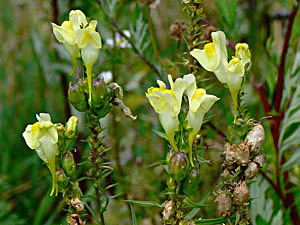
medicinal herbs
Yellow Toadflax
Linaria vulgaris

Herb: Yellow Toadflax
Latin name: Linaria vulgaris
Family: Scrophulariaceae (Figwort Family)
Medicinal use of Yellow Toadflax:
Yellow toadflax has a long history of herbal use. It acts mainly on the liver and was once widely employed as a diuretic in the treatment of oedema. It is little used now, but undoubtedly merits investigation. The whole plant is antiphlogistic, astringent, cathartic, detergent, depurative, diuretic, hepatic, ophthalmic and purgative. It is gathered when just coming into flower and can be used fresh or dried. The plant is especially valued for its strongly laxative and diuretic activities. It is employed internally in the treatment of oedema, jaundice, liver diseases, gall bladder complaints and skin problems. Externally it is applied to haemorrhoids, skin eruptions, sores and malignant ulcers. The plant should be used with caution. It should preferably only be prescribed by a qualified practitioner and should not be given to pregnant women. Dosage is critical, the plant might be slightly toxic. The fresh plant, or an ointment made from the flowers, is applied to piles, skin eruptions etc. The juice of the plant, or the distilled water, is a good remedy for inflamed eyes and cleaning ulcerous sores. A homeopathic remedy is made from the plant. It is used in the treatment of diarrhoea and cystitis.Description of the plant:

Plant:
Perennial
Height:
60 cm(2 feet)

Flowering:
July toOctober
Habitat of the herb:
Hedgerows, by ditches, on dry banks and roadside verges. It is especially abundant in sandy and gravelly soils, and in chalk and limestone districts, and avoids acid soils.Edible parts of Yellow Toadflax:
Young shoots - cooked. Use with caution, see the notes above on toxicity.Other uses of the herb:
A yellow dye is obtained from the whole plant. It is obtained from the flowers according to other reports. A tea made from the plant has been used as an insecticide.Propagation of Yellow Toadflax:
Seed - sow early spring in situ. Division in April or the autumn. Very easy, larger clumps can be replanted direct into their permanent positions, though it is best to pot up smaller clumps and grow them on in a cold frame until they are rooting well. Plant them out in the spring. This species can be divided successfully at almost any time in the growing season.Cultivation of the herb:
Hedgerows, by ditches, on dry banks and roadside verges. It is especially abundant in sandy and gravelly soils, and in chalk and limestone districts, and avoids acid soils.Known hazards of Linaria vulgaris:
One report suggests that the plant might be slightly toxic.Plant information taken from the Plants For A Future.
